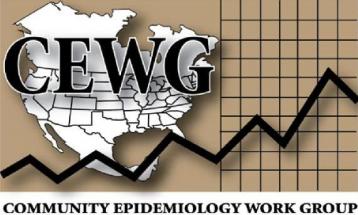Epidemiologic Trends in Drug Abuse, Volume | Executive Summary

Current Trends in Drug Abuse
CEWG
Global Drug Use Statistics and News
United States Drug Use Trends and Statistics
Heroin Price and Purity Data Reports
Overdose Mortality Data
Prescription Drug Abuse Statistics and News
Overview
Originally Published: 09/10/2013
Post Date: 09/10/2013
by CEWG | NIDA
Attachment Files
Epidemiologic Trends in Drug Abuse, Volume | Executive Summary and Highlights
Summary/Abstract
Community Epidemiology Work Group Executive Summary of Drug/Substance Abuse Trends for period ending June 2012.
Content
This Executive Summary provides a synthesis of findings from the 72nd semiannual meeting of the National Institute on Drug Abuse (NIDA) Community Epidemiology Work Group (CEWG) held in La Quinta, California, on June 5–7, 2012. The CEWG is a network of researchers from sentinel sites throughout the United States. It meets semiannually to provide ongoing community-level public health surveillance of drug abuse through presentation and discussion of quantitative and qualitative data.
CEWG representatives access multiple sources of existing data from their local areas to report on drug abuse patterns and consequences in their areas and to provide an alert to potentially emerging new issues. Local area data are supplemented, as possible, with data available from federally supported projects, such as the Substance Abuse and Mental Health Services Administration (SAMHSA), Drug Abuse Warning Network (DAWN); Drug Enforcement Administration (DEA), National Forensic Laboratory Information System (NFLIS); the Arrestee Drug Abuse Monitoring (ADAM) II program; and the DEA, Heroin Domestic Monitor Program (HDMP). This descriptive and analytic information is used to inform the health and scientific communities and the general public about the current nature and patterns of
drug abuse, emerging trends, and consequences of drug abuse.
The CEWG convenes twice yearly, in January and June. For the June meetings, CEWG representatives prepare full reports on drug abuse patterns and trends in their areas. After the meeting, a Highlights and Executive Summary Report is produced, and the full CEWG area reports are included in a second volume.
The majority of the June 2012 meeting was devoted to the CEWG area reports and presentations. CEWG area representatives presented data on local drug abuse patterns and trends. Presentations on drug abuse patterns and issues were also provided by guest researchers from Australia, Canada, the European Centre for Drugs and Drug Monitoring, the Inter-American Drug Abuse Control Commission, Office of American States, and New Zealand. Other highlights of the meeting included presentations by DEA representatives Jeffrey H. Comparin, on the forensic chemistry of drugs of concern, and Sarah Bourne, who gave a drug trafficking update; an update from the Office of National Drug Control Policy on the ADAM II data system by M. Fe Caces, Ph.D.; and a presentation by U.S. Food and Drug Administration representative James Hunter, R.Ph., M.P.H., on the challenges in evaluating abuse deterrent drug
product formulations. Presentations on community-based prescription drug abuse research included “Prescription Opioid Diversion: Mechanisms, Street Prices, and Prevention Measures,” by Steven Kurtz, Ph.D., Nova Southeastern University; “Initiation to Prescription Drug Use: Social Contexts of Use,” by Sheigla Murphy, Ph.D., Center for Substance Abuse Studies, Institute for Scientific Analysis; “Prescription Drug Misuse Among High-Risk Young Adults: Findings from New York and Los Angeles,” by Stephen Lankenau, Ph.D., Drexel University; “Prescription Drug Misuse Among Socially Active Urban Young Adults,” by Brian Kelly, Ph.D., Purdue University; and “Drug Use Practices Among Illicit Users of Pharmaceutical Opioids,” by Robert Carlson, Ph.D., Wright State University.
The Proceedings of the Community Epidemiology Work Group for the June 2012 CEWG meeting is published in two volumes. This volume highlights findings across CEWG areas. Full local area and international reports are presented in Volume II. Readers of this report are directed to Volume II for a more detailed description of data sources and presentation of data from the CEWG areas.





